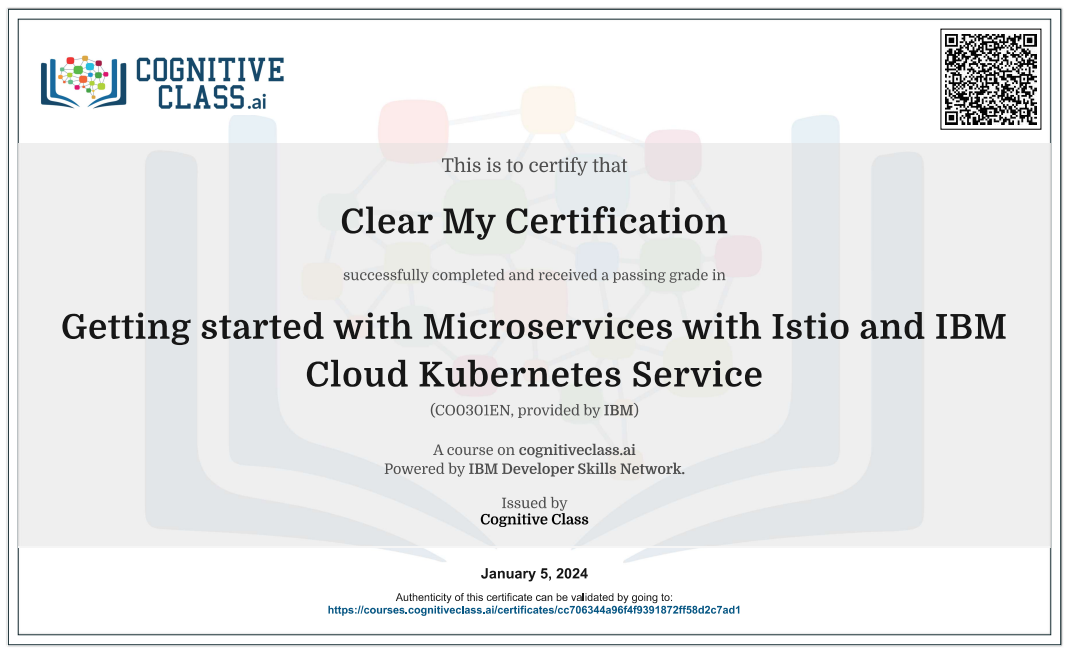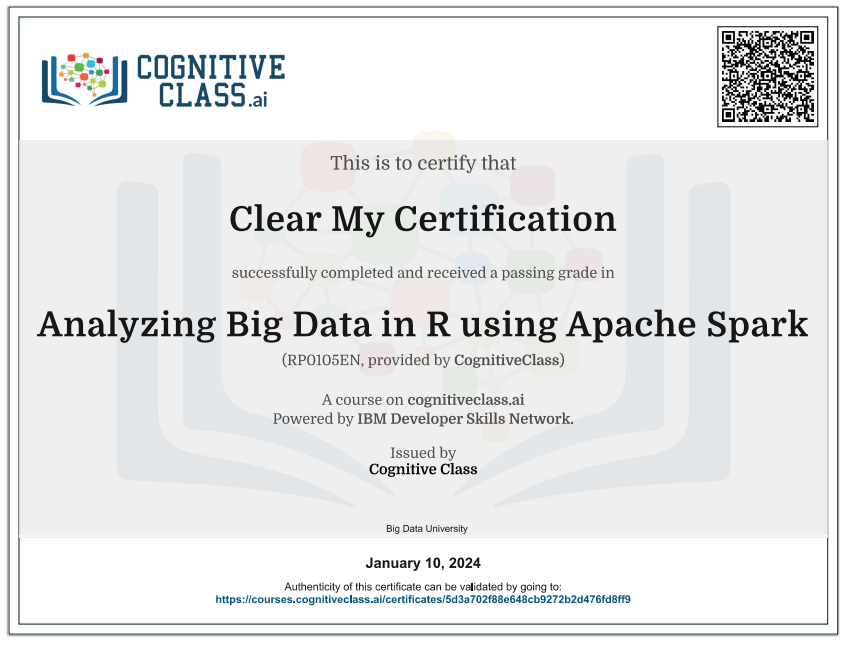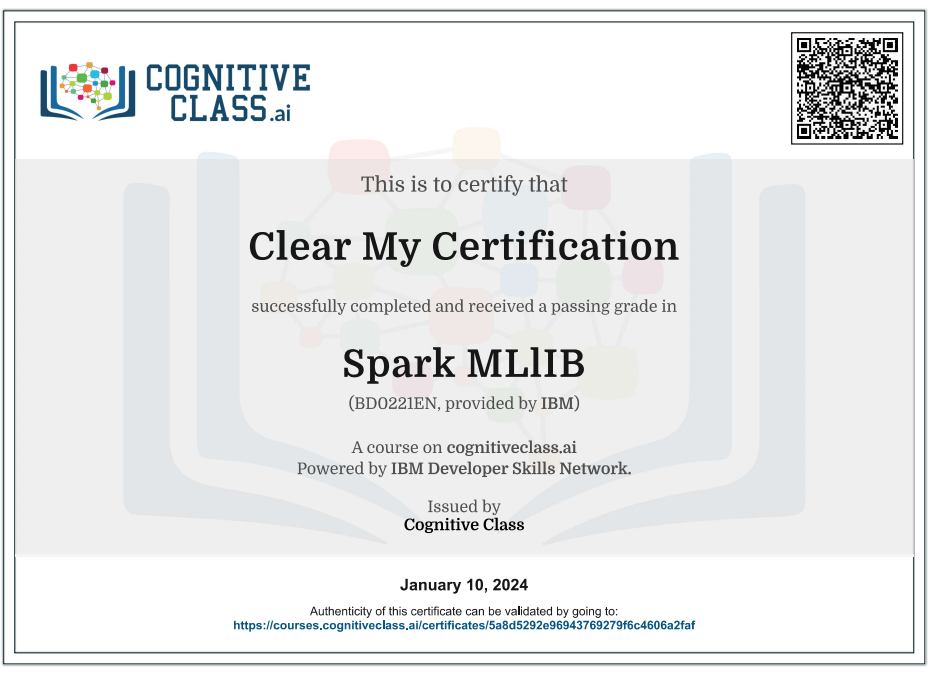Enroll Here: Getting started with Microservices with Istio and IBM Cloud Kubernetes Service Cognitive Class Exam Quiz Answers
Getting started with Microservices with Istio and IBM Cloud Kubernetes Service Cognitive Class Certification Answers

Twelve Factors App Quiz Answers – Cognitive Class
Question 1: The 12-factor app methodology minimizes divergence among development and production, enabling continuous deployment for maximum agility.
- True
- False
Question 2: Disposability refers to which of these concepts?
- An app runs as one or more stateless processes that share nothing and assumes process memory is transient.
- Apps are built in distinct stages (build, release, run).
- Processes start fast and shut down gracefully, which means that processors should start almost instantaneously.
- Developers treat logs as event streams: the outer/hosting environment deals with processing and routing log files.
Question 3: According to the twelve-factor app methodology, where should you store configuration information?
- In the environment
- In the code
- In the server where you deploy the code
- In the properties files
Question 4: When you are trying to build a scalable, distributed, cloud-ready app, you should run that app as one or more stateless processes.
- True
- False
Microservices Quiz Answers – Cognitive Class
Question 1: For a simple change, monolithic apps take a long time to get the updated app redeployed.
- True
- False
Question 2: Select the three benefits of implementing a microservices architecture.
- Different parts of a development team can manage individual parts of a microservice.
- You’ll see less service interruption for fast-paced cloud computing.
- A suite of services can be deployed and upgraded without a rebuild of other functioning services.
- If one component fails, it will all fail.
Question 3: Which principle is exemplified by this statement? “Microservices are an app architectural style that divides an app into components where each component is a full but miniature app that’s focused on producing a single business task.”
- The Single Business Task principle
- The Single Responsibility principle
- The Multiple Component principle
- The Microservices principle
Question 4: Agile development methods helped make microservice design and implementation possible.
- True
- False
Application Architecture Evolution Quiz Answers – Cognitive Class
Question 1: The SOA stack had to string together sequences of services as business processes that were themselves macroservices.
- True
- False
Question 2: A microservice app must have a well-defined interface and well-defined dependencies.
- True
- False
Question 3: What problems do you typically encounter when you develop monolithic apps? Select all that apply.
- No one person can maintain a vertical slice of an app.
- Developer challenges are with DevOps, management views, and controls.
- Developers spend a lot of time in meetings deciding how the layers of code should work together.
- A change in one layer usually broke the layers above it.
Question 4: You can use IBM Cloud Kubernetes Service to repackage monolithic apps into containers.
- True
- False
Microservices Component Architecture Quiz Answers – Cognitive Class
Question 1: The number of business services that you implement for an app depends on what types of clients the app supports and how specialized those clients require their dispatchers to be.
- True
- False
Question 2: In this course, BFF refers to which concept?
- Best friend forever
- Back for front
- Backend for frontend
- Backend first failure
Question 3: You should separate the database access layer into its own service.
- True
- False
Question 4: It’s more efficient and effective to have one team write all or multiple dispatchers while someone else implements the client apps.
- True
- False
Microservice Integration Quiz Answers – Cognitive Class
Question 1: You should not mix and match synchronous and asynchronous communication.
- True
- False
Question 2: By using asynchronous communication, you can make microservices more robust. Which of these actions is not used in asynchronous communication?
- A different requester instance can handle the response.
- The requester, provider, and messages must keep working through the lifetime of the invocation.
- The messaging system holds the action and result.
- The requester doesn’t need to block while the provider runs.
Question 3: Which of these methods help with complete decoupling of microservice intercommunication?
- Service registry or service discovery
- Load balancing
- Circuit breaker patterns
- All of these
Question 4: The public VLAN determines the public IP address that is assigned to a worker node during cluster creation.
- True
- False
Service Mash Quiz Answers – Cognitive Class
Question 1: In monolithic apps, the location of resources are well known, relatively static, and found in configuration files or hard coded.
- True
- False
Question 2: A service registry is used to keep track of the code and health of services.
- True
- False
Question 3: Which of the following common functions are provided by service mesh implementation like Istio? Select all that apply.
- Automated testing
- Service registry
- Service discovery
- Service proxy
Question 4: Client-side discovery uses a load balancer to query the service registry and direct a request to the appropriate service instance.
- True
- False
Istio: An Intelligent Service Mesh for Microservices Quiz Answers – Cognitive Class
Question 1: You add Istio support to services by deploying a special sidecar proxy throughout your environment that intercepts all logs among microservices.
- True
- False
Question 2: Which source projects were the basis for Istio?
- IBM’s Amalgam8 project
- Google’s Service Control
- Lyft’s Envoy proxy
- All of these
Question 3: Istio is an open platform service mesh implementation for connecting, managing, and securing microservices.
- True
- False
Question 4: Select the three benefits of implementing a microservices architecture.
- Different parts of a development team can manage individual parts of a microservice.
- You’ll see less service interruption for fast-paced cloud computing.
- A suite of services can be deployed and upgraded without a rebuild of other functioning services.
- If one component fails, everything fails.
Getting started with Microservices with Istio and IBM Cloud Kubernetes Service Final Exam Answers – Cognitive Class
Question 1: Which component is responsible for collecting telemetry data from the Envoy proxy and other services?
- Citadel
- Kubernetes container
- Mixer
- Pilot
Question 2: What is the core Istio component that is used for traffic management and configuration of all Envoy instances deployed in an Istio service mesh?
- Mixer
- Citadel
- Pilot
- None of these
Question 3: Which of these twelve-factor app methodologies ties into agile software delivery, continuous integration, and continuous deployment concepts, and minimizing incompatibility?
- Admin processes
- Dependencies
- Development and production parity
- Build, release, run
Question 4: Which of these principles when they’re applied to developing microservices can make developers more efficient? Select all that apply.
- Creating well-defined interfaces that are independently deployed
- Managing one large app that does everything
- Operating in small teams with each team owning the entire lifecycle of the service
- Reducing an app into single-function modules
Question 5: You can’t roll back a microservice deployment to a specified version within IBM Cloud Kubernetes Service.
- True
- False
Question 6: 12-factor apps should be scaled up via vertical scaling.
- True
- False
Question 7: The aim of a microservice architecture is to completely link app components to one another so that they can be maintained, scaled, and more.
- True
- False
Question 8: What are the two key tenets of a microservice architecture?
- Services are optimized for multiple functions.
- Communication is done through REST API and message brokers.
- Continuous integration and continuous deployment (CI/CD) are defined per service.
- Business functions are packaged as a single monolith app.
Question 9: Microservices scale and fail interdependently.
- True
- False
Question 10: Which functions enable each service to find and connect with the other services it needs to do its work?
- Sidecar
- Service discovery
- Service registry
- Circuit breaker
Question 11: The Istio service mesh is logically split into which two parts?
- Control plane
- Network plane
- Data plane
- Infrastructure plane
Question 12: The data plane is composed of a set of intelligent proxies deployed as sidecars that mediate and control all security among microservices.
- True
- False
Question 13: The control plane manages and configures proxies to route traffic and to enforce policies at runtime
- True
- False
Question 14: What are the main features of Citadel?
- Service-to-service and end-user authentication using mutual TLS
- Identity management
- Logging management
- Credential management
Question 15: Istio authentication includes key management.
- True
- False
Introduction to Getting started with Microservices with Istio and IBM Cloud Kubernetes Service
Getting started with microservices using Istio and IBM Cloud Kubernetes Service involves several steps. Istio is a service mesh that helps you connect, secure, control, and observe microservices in a Kubernetes cluster. Here’s a high-level guide to help you set up microservices with Istio on IBM Cloud Kubernetes Service:
1. Create an IBM Cloud Account:
- If you don’t have an IBM Cloud account, you’ll need to create one. Visit the IBM Cloud website to sign up.
2. Install and Set Up IBM Cloud CLI:
- Install the IBM Cloud CLI by following the instructions provided.
3. Install Kubernetes CLI (kubectl):
- Install
kubectl, the Kubernetes command-line tool. You can find installation instructions.
4. Provision a Kubernetes Cluster on IBM Cloud:
- Use the IBM Cloud CLI to create a Kubernetes cluster. You can do this with the following command.
- Wait for the cluster to be provisioned.
5. Configure kubectl to Use Your Cluster:
- Retrieve the cluster configuration using the following command.
- Set the
KUBECONFIGenvironment variable to point to the downloaded configuration file.
6. Install Istio on the Kubernetes Cluster:
- Follow the official Istio installation guide for Kubernetes: Installing Istio.
7. Deploy Sample Microservices:
- Deploy sample microservices to your Kubernetes cluster. You can use sample applications like Bookinfo (available in the Istio documentation) to get started.
8. Configure Istio for Your Microservices:
- Define Istio VirtualServices, Gateways, and other resources to configure the behavior of your microservices.
- Apply Istio configuration using
kubectl apply -f <config-file>.
9. Explore Istio Features:
- Take advantage of Istio features such as traffic management, security, and observability. For example, you can set up traffic routing, apply security policies, and use tools like Kiali for observability.
10. Test and Monitor:
- Test your microservices to ensure they are behaving as expected.
- Use Istio’s monitoring tools to observe and analyze the behavior of your services.
11. Scale and Manage:
- Explore Kubernetes features for scaling and managing your microservices.
- Use Istio to manage traffic and apply policies dynamically.
12. Learn and Optimize:
- Continue learning about Istio and Kubernetes features to optimize your microservices architecture.
- Experiment with advanced features and configurations based on your application requirements.
Additional Resources:
- Istio Documentation: Istio Docs
- IBM Cloud Kubernetes Service Documentation: IBM Kubernetes Service Doc
Remember that this is a simplified guide, and you should refer to the official documentation for Istio and IBM Cloud Kubernetes Service for detailed and up-to-date instructions. Additionally, exploring tutorials and examples provided by Istio and IBM Cloud can enhance your understanding and proficiency with these technologies.
 Clear My Certification All Certification Exam Answers
Clear My Certification All Certification Exam Answers



